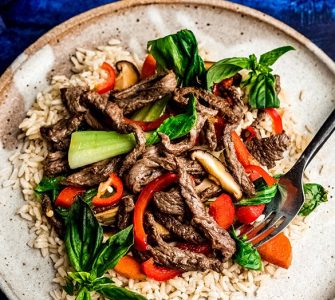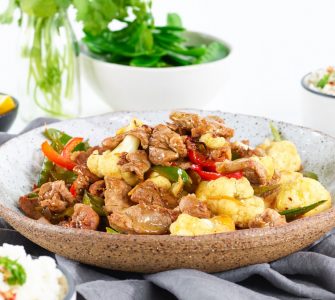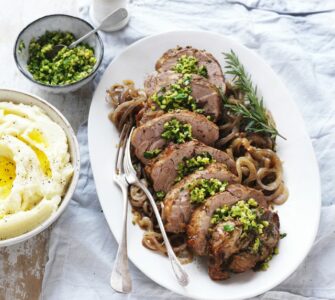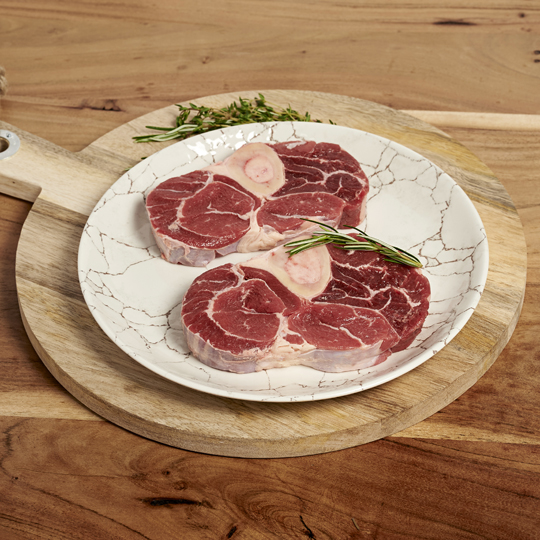Weeknights can be hectic, and weekend lunches often arrive with a crowd and a time limit.
A butterflied leg of lamb solves both these problems.
Removing the bone and opening the lamb leg flat means even cooking and shorter time on heat, while a high-temperature tray of vegetables can roast alongside without fuss. Think lemon, garlic, and herbs for the lamb, and tahini, lemon, and water for a quick dressing that adds creaminess without dairy. Rest the meat well, slice across the grain, and plate with a bright drizzle and a sprinkle of dukkah. The method is straightforward, flexible with whatever spring produce looks good, and scales easily.
So dinner feels generous, not stressful.
What “Butterflied” Means—and Why It’s Faster
A butterflied leg is a bone-out lamb leg opened into a large, fairly even slab. The extra surface area helps heat reach the centre sooner than a whole roast, so you get dinner on the table sooner with less risk of undercooked centres or overcooked edges. A little unevenness is normal; the thinner edges cook a touch further, which suits different preferences at home. After cooking, rest the lamb loosely covered so juices settle, then carve across the grain into broad slices. This gives tender bites and tidy plating, whether you’re feeding family or a few friends.
Marinade and Prep Fundamentals
Keep the flavours bold and simple: lemon juice, olive oil, crushed garlic, and oregano or rosemary. Even a short soak improves seasoning; a few hours (or overnight in the fridge) deepens flavour. Bring the lamb out of the fridge about 30 minutes before cooking so the chill comes off and searing is more even. If you plan to use any leftover marinade as a sauce, boil it for a minute to make it safe. Meanwhile, preheat your grill or oven properly—good heat upfront is what builds colour quickly without drying the meat.
Cooking Methods: BBQ vs. Pan + Oven
For the barbecue, preheat to about 220 °C. Cook over indirect heat with the presentation side down for roughly 15 minutes, then flip and cook about 10 minutes more, checking with a thermometer to hit your preferred doneness, rest 10–15 minutes before slicing. In apartments or when the weather’s off, use a hot oven-safe pan to sear the lamb 2–3 minutes a side, then finish in a 180 °C oven until the centre climbs to target temperature. Either way, carve against the grain and keep the board close, so juices return to the plate rather than the benchtop.
Doneness Guide (Internal Meat Temperatures)
Use a probe thermometer for accuracy—poke into the thickest part and avoid any seams of fat.
- Rare: 55–60 °C
- Medium-rare: 60–65 °C
- Medium: 65–70 °C
- Medium-well: 70–75 °C
- Well-done: 75 °C+
- Carryover heat is your friend: remove the lamb about 3–6 °C shy of your target. As it rests, the temperature rises and fibres relax, giving juicy slices that hold up on the plate and in tomorrow’s lunch.
Serving, Sides, and How to Plate
Slice the rested lamb into generous, even pieces and fan them on a warm platter. Spoon over half the tahini dressing—just tahini, lemon, and enough water to reach a pourable consistency—and pass the rest at the table. Add a sprinkle of dukkah for crunch and warmth. Roast vegetables bring colour and sweetness: pumpkin, capsicum, and zucchini work well on a hot tray while you cook the lamb. Keep a lemon wedge or two on hand to brighten the whole plate, especially if you’ve leaned into garlicky, herby flavours.
Spring Swaps from Melbourne Markets
Lean into what’s fresh. Asparagus, broccolini, and sugar snaps roast beautifully—toss them onto the tray for the final 8–10 minutes so they stay crisp-tender. New potatoes benefit from a quick parboil before roasting; they’ll crisp up without drying out. If you’re using extra zucchini, cut it a little thicker so it stays juicy. Aim for a 220 °C oven for vegetables and adjust the time to suit the size of each cut. Season simply with olive oil, salt, and pepper, then finish with lemon zest for lift.
Butcher and Carving Tips
When ordering, ask for a fairly even butterfly—tidied lobes and thick pockets trimmed to help you cook more predictably. Plan roughly 200–250 g raw lamb per adult, depending on sides and appetites. After cooking, rest the leg under loose foil, then slice across the grain into wide pieces. Keep your carving board close to the serving platter and tip any resting juices back over the meat or into the dressing. These small details make a noticeable difference to succulence and presentation.
Why the Flavours Work
Lemon, garlic, and herbs give lamb a clean, savoury backbone that doesn’t fight the meat’s natural character. The tahini dressing adds nuttiness and body without feeling heavy, and it doubles as a quick sauce for the vegetables. A pinch of dukkah brings texture and gentle spice, so you get crunch and warmth in the same forkful. It’s a simple equation: season well, cook hot for colour, rest properly, then finish with something fresh so the plate feels balanced.
A Practical Time Plan
Here’s a simple timeline you can follow on autopilot:
- 0:00 Mix marinade; coat lamb (or do this the night before).
- 0:05 Heat the oven to 220 °C and tray the vegetables.
- 0:15 Vegetables go in; lamb stands 30 minutes at room temp if just out of the fridge.
- 0:30 Preheat BBQ to 220 °C (or preheat oven to 180 °C if finishing inside).
- 0:35–0:50 Cook lamb (BBQ about 25 minutes to medium; or pan-sear then oven to temp).
- 0:50–1:05 Rest 10–15 minutes; whisk tahini; slice and serve.
Leftovers That Feel New
Pack leftover lamb with roasted vegetables for the next day’s carb free lunch. For a quick grain bowl, add herbs, a handful of rocket, and a spoonful of tahini dressing. Warm pita pockets also work—tuck in sliced lamb, crisp veg, and a squeeze of lemon. The dressing keeps in the fridge for a couple of days; loosen with water if it thickens. These easy second-uses mean less waste and faster meals when time is tight.
Ingredients
- 1.5 kilogram Butterflied lamb leg (trimmed of excess fat)
- 1 Lemon juice
- 2 tablespoon Olive oil (extra virgin)
- 800 gram Kent pumpkin (peeled and cut into 2cm thick wedges)
- 2 Red capsicums (seeded and cut into 4 cm pieces)
- 2 Zucchini (cut on diagonal in 4 cm pieces)
Tahini dressing
- 2 tablespoon Tahini paste
- 1 tablespoon Lemon juice
- 1-2 tablespoon Water
- Dukkah (to serve)
Instructions
- Preheat oven to 220°C for the vegetables. Place lamb on a baking tray and squeeze over the juice of half a lemon. Drizzle with 1 tablespoon of oil and season with salt and pepper. Cover loosely with foil and leave at room temperature for 30 minutes.
- Place pumpkin, capsicum and zucchini on two baking trays, drizzle with 1 tablespoon of oil and season with salt and pepper and toss to coat. Roast for 35-40 minutes until vegetables are golden and cooked through.
- Preheat a barbecue to 220°C and cook lamb over an indirect heat for 15 minutes, serving side down. Turn the lamb over and cook for another 10 minutes for medium, or until a thermometer reads 60-65°C. Cover loosely with foil and rest for 15 minutes.
- To make tahini dressing, whisk the tahini paste, lemon juice and water in a small bowl until the consistency of thickened cream. Season with salt and pepper to taste. Carve the lamb against the grain and serve with roasted vegetables, tahini dressing and a sprinkling of dukkah.
Notes
- Make sure the lamb is an even thickness so that it cooks evenly. You can do this yourself or ask your butcher to prepare it for you.
- You’ll find tahini paste in most supermarkets, generally in the health food section.
- If you can’t find butterflied lamb leg, try a butterflied shoulder, rump roast or leg steaks.
Order and Prep Made Easy
If you’re nearby, order a butterflied leg prepared to your preferred thickness from Church Street Butcher, or drop in and chat through BBQ versus oven options while you shop. Grab your vegetables in the same run, and dinner practically organises itself.
 Beef Stir Fry With Brown Rice
Beef Stir Fry With Brown Rice Easy Pork Stir-Fry
Easy Pork Stir-Fry Savour a Classic Aussie Pork Scotch Roast with Olive Gremolata—Cook Once, Feast All Week
Savour a Classic Aussie Pork Scotch Roast with Olive Gremolata—Cook Once, Feast All Week
